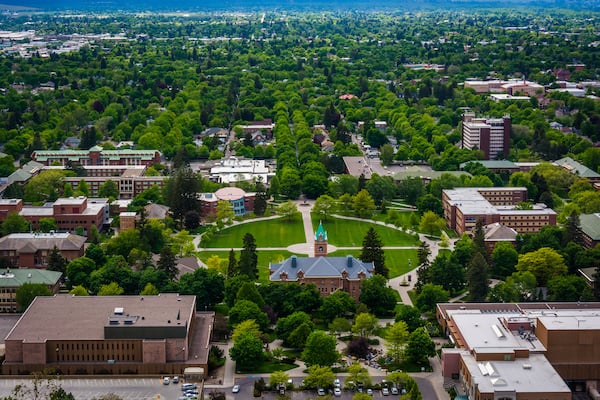Published on
A Vision for Flagship Universities: Engaging Learners Beyond Traditional Scope

At its root, the institution’s mission is to serve its learners. But even the slightest shift can be uncomfortable. As the demographic cliff looms over higher education, even flagship universities are looking for new and creative ways to engage learners beyond their traditional scope. And positioning your institution for success will take hard, collaborative work. In this interview, Seth Bodnar discusses the importance of engaging new learners, what this will require and other innovative ways to help reshape institutional strategy to align with modern learners.
The EvoLLLution (Evo): Why is it so important for modern universities to explore new and creative ways to engage with more diverse learner populations?
Seth Bodnar (SB): I tell people that when you think about the University of Montana and its mission, you can boil it down to two words: inclusive prosperity. We are a world-class university with tremendous academic programs, exceptional faculty and motivated students. That’s something we’re very proud of. But at UM, we do not measure excellence by exclusivity. If we’re paying attention to the crux of our mission–and its modern relevance—we know that our job is to help every single member of our community–from all backgrounds and walks of life – reach their unique, full potential and to foster economic growth in our community that is both sustainable and inclusive. We must embrace the fact that our mission as a flagship university is not just to provide a diverse range of educational pathways for traditional college students, but also to provide this access for people at all stages of their lives and careers.
America is reckoning with the big idea of what a college degree is supposed to offer. And that’s a healthy, necessary conversation to have. To be clear, I’m not saying it’s an easy one. But we know the days of going to college from age 18 to 22, and then working for a company for 30 years, and getting your watch and pension upon retirement. Those days are over (if they ever really existed). This country cannot rely on that now fictional story and expect our students and community to buy into it.
But rather than adapting to this economic and societal change, we see many flagships still narrowly focusing on those traditional undergrad and graduate students, fighting for a larger share of a shrinking college-age demographic. At the University of Montana, we’re asking ourselves big and brave questions about how we must adapt and deliver post-secondary education that responds to the actual stories of people’s lives. We cannot do that by continuing to narrow who can access higher education, but rather by expanding that access. We have an obligation to do more for our communities, and we have to be agile and creative to meet this significant shift in our economy.
Evo: Is it purely a mission imperative that is pushing a renewal in terms of focus or is it a sustainability imperative as well in terms of ensuring that there’s viability in the market, ensuring that the numbers of prospective learners match up with the expenses of running a major flagship?
SB: No organization that can’t effectively execute its mission will be sustainable over the long run. That’s as true in the private sector as it is in public education. UM was founded in 1893, just about 130 years ago and in a very different context than we face today. Our mission is similar, but the way we carry out that mission has to adapt so that we can sustain ourselves as an organization. Our charter language was written at the turn of the century when Montana – a relatively new U.S. state – was wrestling with how to stand-up an institution for higher education for its populous.
Of course, 130 years on, we have to acknowledge change as a constant, while understanding that we are fully capable of both honoring our traditional mission and remaining relevant for future generations. Tradition and adaptive change are not mutually exclusive; at UM, they are a powerful dual engine for sustainability. Creativity, adapting to market demand and fostering innovation can be scary ideas for brick-and-mortar historical institutions. But I would argue that we in higher ed have the opportunity to serve as lighthouses of change, which is why I challenge our university to continually ask ourselves, “What does our society demand of a flagship of the future?”
In this vein back in ‘21, I outlined three main ways in which we must adapt to better serve our community, our state, and this republic as a flagship university of the future. One, we have to significantly reform our curriculum by more intentionally building in our students those foundational competencies – critical thinking, teamwork, effective communication, the ability to synthesize complex information and solve unscripted problems – that we know are vital to success in a global, digital economy. Second is ensuring that every student – regardless of academic discipline – gets significant work-based and experiential learning as a key component of their UM experience. And finally, we must broaden our aperture to consider a wider range of learners whose needs we must serve. Because while the demographic cliff is real, I would argue that the demand for learning and education in our rapidly changing economy has never been higher. It’s just in places and in learner populations that flagship universities haven’t typically served.
Some may say this challenges the very idea of a traditional four-year, broad-based, liberal arts education. But to stay true to our charter and to effectively serve the needs of our state, we must adapt.
Evo: How do you create an environment where people are comfortable to start making changes, especially in a space that generally isn’t open to shifts?
SB: You have to do so carefully, and you have to weave those initiatives into the organization in places where innovation won’t be smothered. As Clayton Christensen said, you have to find a place within the organization where you can experiment with new models and try to gain traction. For our Accelerate Montana initiative – which is focused on partnering directly with employers to develop, short-term, rapid training programs – we utilize faculty from the university but through a different vehicle than their traditional college structure. We gain credibility when programs like this work, when they’re well-planned and expertly executed. Those external successes build internal trust. I do appreciate (at times) heavy skepticism from the inside, but when our students are getting jobs, when business are created, and when there is visible human and economic impact from creative thinking and risk-taking, that’s evidence of smart and healthy change.
And to be clear, this approach doesn’t threaten our more traditional programs. In fact, we are working to create pathways through short-term, non-credit programs that prepare learners for jobs right now, while also enabling them to progress – while they’re still working – to a two-or-four-year degree that will allow them to adapt and succeed throughout their entire career. When we get this right, it’s a win for the learner, it’s a win for the employer and it’s a win for the university. But before we get to that, we have to prove that the model will work, which we’re doing through Accelerate Montana and in several other corners of campus
Evo: As you look 10 years into the future, what does higher education look like and how is it different than what we’re seeing today?
SB: I give credit to people like Brandon Busteed and others who explore what I believe is a false dichotomy between a student being broadly educated or specifically skilled. We have to move away from this either-or. A graduate today must be both broadly educated and specifically skilled.
Let’s say we live in a world where maybe 20% of students will be working in jobs 10 years from now that don’t exist today. Are we prepared for that? Are we afraid of that? Are we doing enough to forecast and respond? According to a New York Fed study a few years ago, 74% of college graduates are working in fields not directly related to their undergraduate major. We all know that intuitively, but we don’t embody that in the way that we educate. So, we have to focus on building those foundational competencies that enable students to adapt and succeed in their fifth or sixth job, while also ensuring that they gain specific skills through work-based and experiential learning while in college to secure that first job after graduation. These goals are not mutually exclusive, and I have full faith we have the knowledge and capacity to do this. It just takes a bit of courage.
I also think colleges in the future must aspire to be a lifelong learning home for students. We need to be the place for graduates come back to – again and again, maybe several times throughout their careers – to re-skill, to upskill or to enable that mid-career transition. That doesn’t always look like another four-year degree. It might be a semester, a credential or a certificate that complements their educational and career trajectory but enables them to pivot in a new direction. That means adapting and perhaps unbundling our offerings to be more accessible for people. It’s not easy to do this, of course, but that’s what society will demand of a flagship of the future.
Evo: From a leadership perspective, what does it take to create a coordinated strategic approach to non-degree programming so that it doesn’t exist as something opportunistic but instead as something that’s inherent?
SB: You have to build some momentum, show that you’re committed to this and get some proof of success. Then you have to work to build the bridges between non-credit and for credit. Then think back to the incentive structures.
Let me share an example. Back in 2021, I spoke to legislators in Montana about the importance of innovative workforce development efforts to address our labor shortage. However, our current incentive structure doesn’t reward us for doing those things. So, I asked for one-time only funding in partnership with the Department of Labor and Industry here in Montana, as well as the Department of Commerce.
And in less than a year our Accelerate Montana program had 1,200 learners complete various programs and credentials… with a good percentage of them entering into jobs in high-demand sectors such as coding, commercial driving, construction, CNA’s, boiler operation, welding, heavy equipment operating, electrical technician, software modeling, dental assisting, and numerous other offerings.
Accelerate Montana is a success story of the Montana University System. But despite creating the curriculum, hiring instructors, providing the facilities or software for students to learn, and marketing these services to both students and employers, you won’t see these additional 1,200 learners in our enrollment reports or our funding calculations.
Of course, we need to address the incentive structures to ensure that programs like this are sustainable over the long-run. But that comes second. First you need to get some wins, then you can address those incentive structures. And by the way, those tangible wins also make faculty more willing to experiment and try new things. It creates a positive feedback loop.
This experiment in the way we deliver education to a broader range of learners is an expression of UM’s ongoing commitment to our traditional mission, through adaptation.
Evo: Is there anything you’d like to add about starting to execute on this vision of the flagship of the future and the obstacles that you see standing in the way?
SB: Public flagship universities have a vital role to play for this country. When you look at the social unrest, on both the left and right, I think at the core of much of it is a profound sense of a lack of opportunity. People feel that the system is rigged, that if you’re not born in the right zip code with the right parents and access to a so-called elite school, you don’t have a chance to get ahead. So, we turn to attacking each other or the imagined narratives of what our institutions stand for. We have the opportunity today to change that to renew the social contract of higher education and to be an engine of social mobility in this country.
That requires us to adapt, and it is hard, and there are real, entrenched barriers to change in higher ed. But it’s worth it. As someone who served our country in a military uniform on active duty for more than a decade, I believe without a doubt that the work we’re doing at the University of Montana is the most important work for the long-term health of our country that I’ve ever been a part of. And I know that better is possible. I’m excited about the progress we’ve made, but I’m even more excited about what lies ahead.
This interview was edited for length and clarity.
Author Perspective: Administrator



